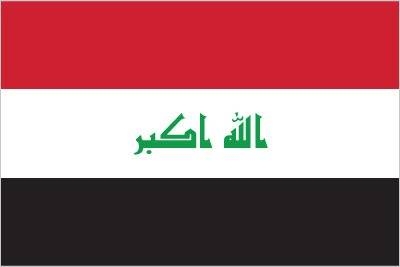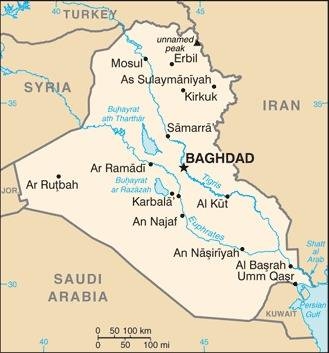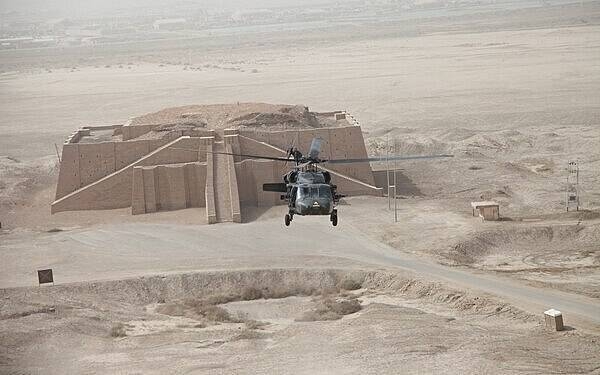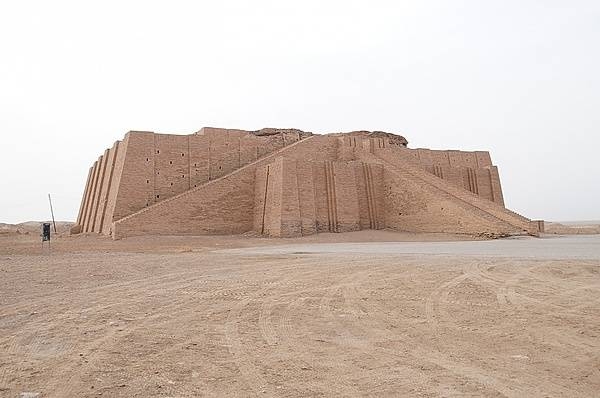143 Iraq

Three equal horizontal bands of red (top), white, and black. The Takbir (Arabic expression meaning “God is great”) in green Arabic script is centered in the white band. The band colors derive from the Arab Liberation flag: black represents oppression, red represents overcoming through bloody struggle, and white means to be replaced by a bright future. The Council of Representatives approved this flag in 2008 as a compromise replacement for the Ba’thist SADDAM-era flag.
Flag courtesy of the CIA World Factbook

Map courtesy of the CIA World Factbook


The Great Ziggurat of Ur stands after 4,000 years. Construction on the ziggurat was completed in the 21st century B.C. in the ancient Sumerian city of Ur near present-day Nasiriyah on the Euphrates River, about 370 km (225 mi) southeast of Baghdad. The ziggurat was part of a temple complex that served as an administrative center for the city, and that was also a shrine of the moon god Nanna, the patron deity of Ur. The site was extensively excavated between 1922 to 1934. Part of the facade of the lower stage and the ceremonial stairway were reconstructed by the regime of Saddam Hussein. The Great Ziggurat at Ur viewed from a Black Hawk helicopter.
Photos courtesy of the CIA World Factbook
Government
According to Britannica, from 1968 to 2003 Iraq was ruled by the Baʿath (Arabic: “Renaissance”) Party. Under a provisional constitution adopted by the party in 1970, Iraq was confirmed as a republic, with legislative power theoretically vested in an elected legislature but also in the party-run Revolutionary Command Council (RCC), without whose approval no law could be promulgated. Executive power rested with the president, who also served as the chairman of the RCC, supervised the cabinet ministers, and ostensibly reported to the RCC. Judicial power was also, in theory, vested in an independent judiciary. The political system, however, operated with little reference to constitutional provisions, and from 1979 to 2003 Pres. Saddam Hussein wielded virtually unlimited power.
Following the overthrow of the Baʿath government in 2003, the United States and its coalition allies established the Coalition Provisional Authority (CPA), headed by a senior American diplomat. In July the CPA appointed the 25-member Iraqi Governing Council (IGC), which assumed limited governing functions. The IGC approved an interim constitution in March 2004, and a permanent constitution was approved by a national plebiscite in October 2005. This document established Iraq as a federal state in which limited authority—over matters such as defense, foreign affairs, and customs regulations—was vested in the national government. A variety of issues (e.g., general planning, education, and health care) are shared competencies, and other issues are treated at the discretion of the district and regional constituencies.
The constitution is in many ways the framework for a fairly typical parliamentary democracy. The president is the head of state, the prime minister is the head of government, and the constitution provides for two deliberative bodies, the Council of Representatives (Majlis al-Nawwāb) and the Council of Union (Majlis al-Ittiḥād). The judiciary is free and independent of the executive and the legislature.
The president, who is nominated by the Council of Representatives and who is limited to two four-year terms, holds what is largely a ceremonial position. The head of state presides over state ceremonies, receives ambassadors, endorses treaties and laws, and awards medals and honors. The president also calls upon the leading party in legislative elections to form a government (the executive), which consists of the prime minister and the cabinet and which, in turn, must seek the approval of the Council of Representatives to assume power. The executive is responsible for setting policy and for the day-to-day running of the government. The executive also may propose legislation to the Council of Representatives.
The Council of Representatives does not have a set number of seats but is based on a formula of one representative for every 100,000 citizens. Ministers serve four-year terms and sit in session for eight months per year. The council’s functions include enacting federal laws, monitoring the performance of the prime minister and the president, ratifying foreign treaties, and approving appointments; in addition, it has the authority to declare war.
The constitution is very brief on the issue of the Council of Union, the structure, duties, and powers of which apparently will be left to later legislation. The constitution only notes that this body will include representatives of the regions and governorates, suggesting that it will likely take the form of an upper house.
Iraq is divided for administrative purposes into 18 muḥāfaẓāt (governorates), 3 of which constitute the autonomous Kurdistan Region. Each governorate has a governor, or muḥāfiẓ, appointed by the president. The governorates are divided into 91 aqḍiyyah (districts), headed by district officers, and each district is divided into nāḥiyāt (tracts), headed by directors. Altogether, there are 141 tracts in Iraq. Towns and cities have their own municipal councils, each of which is directed by a mayor. Baghdad has special status and its own governor. The Kurdish Autonomous Region was formed by government decree in 1974, but in reality it attained autonomy only with the help of coalition forces following the Persian Gulf War. It is governed by an elected 50-member legislative council. The Kurdistan Region was ratified under the 2005 constitution, which also authorizes the establishment of future regions in other parts of Iraq as part of a federal state.
Judicial affairs in Iraq are administered by the Supreme Judicial Council, which nominates the justices of the Supreme Court, the national prosecutor, and other high judicial officials for approval by the Council of Representatives. Members of the Supreme Court are required to be experts in civil law and Muslim canon law and are appointed by two-thirds majority of the legislature. In addition to interpreting the constitution and adjudicating legal issues at the national level, the Supreme Court also settles disputes over legal issues between national government and lower jurisdictions. During the Baʿath era the judiciary was generally bypassed, and the regime instituted a wide variety of exceptional courts whose authority circumvented the constitution. The establishment of such courts is clearly proscribed under the 2005 constitution. All additional courts are to be established by due process of law.
Iraq Civil Aviation Authority (ICAA)
The Iraq Civil Aviation Authority (ICAA) is the agency responsible for Iraq’s obligations under the provisions of Annex 9 (Facilitation) of the Chicago Convention. The ICAA is responsible for coordinating with other Iraq agencies for the development and implementation of policy and coordination of ICAO matters.
Airspace
SkyVector – Google Maps – ADS-B Exchange
ICAO countries publish an Aeronautical Information Publication (AIP). This document is divided into three parts: General (GEN), En Route (ENR) and Aerodromes (AD). ENR 1.4 details the types of airspace classes they chose to adopt from classes A through G.
Drone Regulations
ICAR No.20 Operations Part A. – RPAS rules
Advanced Air Mobility (AAM) Regulations & Policies
None found by the author.
However, should you, the reader, happen to stumble across something to the contrary, please email the author at FISHE5CA@erau.edu and you may be mentioned in the ACKNOWLEDGEMENTS section of this book by way of thanks for contributing to this free eBook!
Advanced Air Mobility (AAM) News
None found by the author.
However, should you, the reader, happen to stumble across something to the contrary, please email the author at FISHE5CA@erau.edu and you may be mentioned in the ACKNOWLEDGEMENTS section of this book by way of thanks for contributing to this free eBook!
Short Essay Questions
Scenario-Based Question
You have been hired by a Drone Startup Company. Your boss has immediately assigned this job to you.
They need you to prepare a one-page memo detailing the legalities of using a drone to film the Great Ziggurat of Ur, pictured above.
They need you to mention any national laws and local ordinances.
They specifically want to know what airspace (insert pictures) you will be operating in and whether or not you need an airspace authorization.
Does it matter whether or not you are a citizen of the country?
Lastly, there is a bonus for you if, as you scroll through this chapter, you find any typos or broken links!
Short Essay Questions
- What are the drone categories?
- How is registration addressed?
- How is remote ID addressed?
- What are the model aircraft rules?
- What are the commercial drone rules?
- Are there waivers or exemptions to the rules? If so, for what?
- Would you share a link to an interactive airspace map?
- How is BVLOS addressed?
- How can you fly drones at night?
- How can you fly drones over people?
- Where do you find drone NOTAMs?
- What are the rules for drone maintenance?
- What are the rules for an SMS program?
- What are some unique rules not mentioned above?
- What are the C-UAS rules?
- What are the AAM rules?

